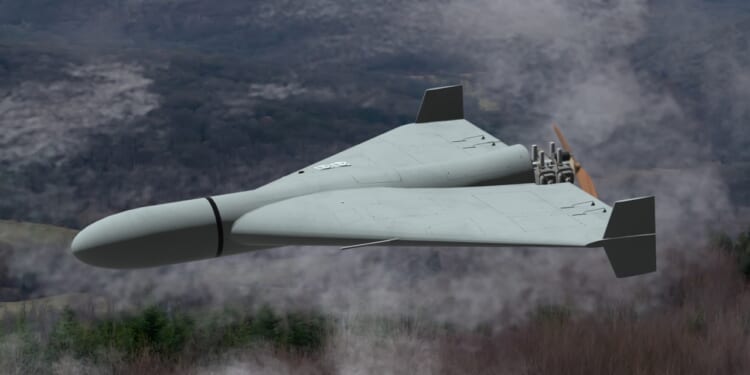While low-tech and prone to malfunctions, the Gerbera drone is the embodiment of the principle that quantity has a quality of its own.
Crisis continues gripping the European members of NATO. A wave of presumably Russian drones has penetrated the airspace of various European NATO members, prompting castigations from the leaders of those countries and vows of retaliation from those countries.
The first incident in this new wave of purported Russian aggression toward Europe occurred in Poland.
The Gerbera Drone’s Specifications
Most reports indicate that the Russian drones in question were known as “Gerbera” type drones. These systems are low-cost, multipurpose unmanned aerial vehicles (UAVs) developed and produced by Russia. They’re basically simplified (and cheaper) variants of the Iranian-made Shahed-136 kamikaze drone, which Russia refers to as the “Geran” series.
The Gerbera is constructed from inexpensive materials like plywood and foam, making it lightweight, expendable, and suitable for mass production.
- Year Introduced: 2024
- Number Built: Unknown; likely thousands (estimated production 400-600 per month)
- Length: 2 m (6.56 ft)
- Wingspan: 2.5 m (8.2 ft)
- Weight: Unknown
- Engines: Pusher propeller driven by internal combustion engine
- Top Speed: ~160 km/h (100 mph)
- Range: ~600 km (373 miles)
- Service Ceiling: Approx. 3,000 m (9,800 ft)
- Loadout: ~18 kg (39.7 lb) explosive payload
- Aircrew: 0 (drone)
Russia assembles their Gerbera drones at the large Yelabuga facility, emphasizing affordability and swarm deployment over advanced technology. Of course, because these systems are so cheap and simple—costing only around $10,000 per unit, a fraction of the price of a conventional Shahed/Geran drone—they are subject to navigational errors. Warsaw believes the penetration of their airspace was intentional by Russia. Moscow denies this, and had the incursion been a one-time incident, it might have seemed plausible that the drones crossed into Polish airspace by accident. Since that time, however, there have been more incidents involving Russian systems violating NATO airspace.
Russia has deployed their Gerbera drones extensively in the ongoing Ukraine War since 2024, using them primarily as decoys designed to overwhelm and deplete Ukrainian air defenses. The drones; low cost allows them to be used in large numbers during airstrikes, forcing defenders to expend valuable resources on cheap targets like the Gerbera, while more sophisticated threats follow. Ukrainian intelligence describes the drones as long-range kamikaze drones, though they can also serve reconnaissance or distraction roles.
Recent reports suggest that Russia has begun equipping their Gerbera drones with modifications, such as rear-facing cameras or optical sensors to detect approaching interceptors and perform evasive maneuvers, enhancing their survivability in contested airspace. In certain areas of the Ukraine War, Gerberas have been used alongside Russian reconnaissance drones, like Supercam and Zala.
Ukraine Has Some Countermeasures to the Gerbera
Interestingly, Ukraine has reported destroying many Gerberas in their growing counter-drone operations. Russia has also integrated them into broader drone strategies, reducing reliance on more detectable reconnaissance UAVs after heavy losses.
Indeed, Ukraine has adapted effectively to the Gerbera drone threat, achieving high interception rates. According to Natasha Lindstaedt of Forbes, the Ukrainians have become so proficient in countering the Gerbera threat to their forces that they today enjoy an 80-90 percent interception rate.
Some of the methods Ukraine has deployed to counter the Gerbera threat include the use of first-person-view (FPV) interceptor drones. Mi-8 helicopters with machine guns and thermal imagers have destroyed multiple Gerberas in single sorties, with one reported incident destroying four Gerbera drones alongside six Shahed drones. Ukrainian F-16s have also been deployed against Russian Gerbera drones recently. These F-16s, firing AIM-9 missiles, marked some of the first confirmed kinetic uses of these jets in the conflict.
Despite these successes, however, the sheer volume of Gerbera launches continues to strain Ukrainian resources.
Ukraine has also targeted production sites within Russia itself, even striking the Yelabuga complex to disrupt Shahed and Gerbera assembly. Meanwhile, in the wake of the Gerbera incursions into NATO airspace, Europe is desperately trying to formulate defenses against the Gerbera. Thus far, there has been little headway in this mission.
The bottom line is that, while low-tech and prone to malfunctions, the Gerbera is the embodiment of the principle that quantity has a quality of its own. The United States and its NATO partners must forthrightly develop real defenses against this threat—as it is only worsening.
About the Author: Brandon J. Weichert
Brandon J. Weichert is a senior national security editor at The National Interest. Recently, Weichert became the host of The National Security Hour on America Outloud News and iHeartRadio, where he discusses national security policy every Wednesday at 8pm Eastern. He is also a contributor at Popular Mechanics and has consulted regularly with various government institutions and private organizations on geopolitical issues. Weichert’s writings have appeared in multiple publications, including The Washington Times, National Review, The American Spectator, MSN, The Asia Times, and others. His books include Winning Space: How America Remains a Superpower, Biohacked: China’s Race to Control Life, and The Shadow War: Iran’s Quest for Supremacy. His newest book, A Disaster of Our Own Making: How the West Lost Ukraine is available for purchase wherever books are sold. He can be followed via Twitter @WeTheBrandon.
Image: Shutterstock / Anelo.


















